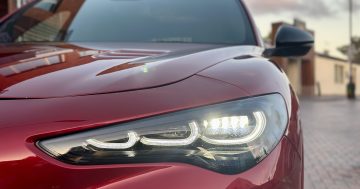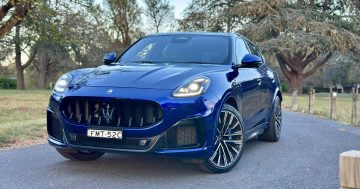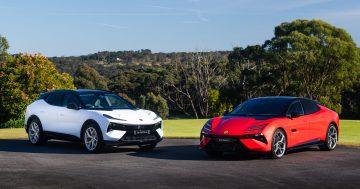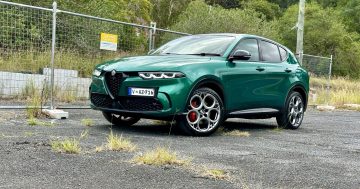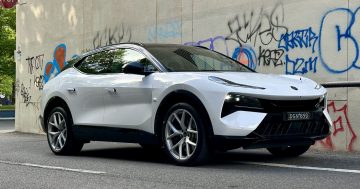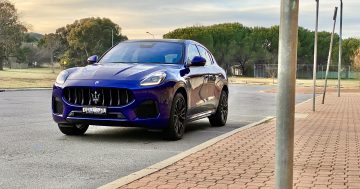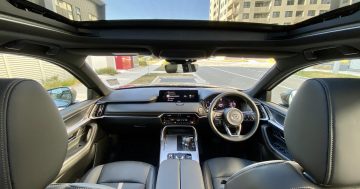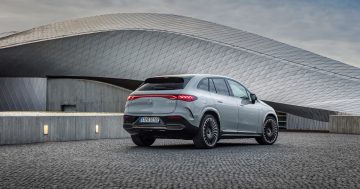By Karl Peskett.
Bentley Bentayga? Hardly. Rolls-Royce Cullinan? Nope. Sorry, but the title of the world’s most expensive SUV goes to the Karlmann King.
Looking like Darth Vader has ordered a bespoke Lexus LX, it’s one of the most imposing figures on the roads. And you can have it in optional bulletproof form. So what is it, exactly?
It’s basically a Ford F-550 underneath – itself a behemoth – but the carbon-fibre bodywork has been designed by a IAT, a Chinese auto parts manufacturer. At 5990mm long, 2480mm wide and 2480mm high, the Karlmann King definitely makes an impact.
The engine is the F-550’s 6.8-litre V10 with Ford’s six-speed auto and the engine has 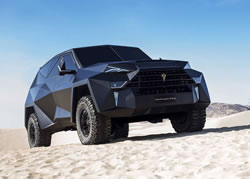 been worked to now make just shy of 300kW, but if you think that a V10 is going to make the King full of fire and brimstone, think again. The King’s size and weight (4.5-tonnes) means it only has a top speed of – wait for it – 140kmh. Add the optional bulletproofing and the weight goes up to 6.0-tonnes.
been worked to now make just shy of 300kW, but if you think that a V10 is going to make the King full of fire and brimstone, think again. The King’s size and weight (4.5-tonnes) means it only has a top speed of – wait for it – 140kmh. Add the optional bulletproofing and the weight goes up to 6.0-tonnes.
Six tonnes and a near seven litre V10? Yeah, fuel consumption probably won’t be great. Not that you care if you’ve ordered one.
Every Karlmann is said to be unique, and they’re also hand-built in Europe. The interior gets a Rolls-Royce-like starlight headlining and given the overall size of the thing, you won’t have to worry about leg room.
Both front and rear passengers get their own climate control, of course, but if you’re in need of an espresso, there’s a coffee machine. You can have neon lighting, an LED TV (4K, of course), electrically operated tables, private safes, an air purifier, a fridge, and all of it is controlled through your smartphone. Let’s not forget the stereo, which is linked to the TV and a PlayStation 4 console. Want satellite TV? No problem. Satellite phone? Here you are, sir.
We’re told that only 12 vehicles will be created, but at US$2.2 million, you’ll need to be quite well heeled to park one in your driveway.
Lambo says no to ‘Ring record
The Green Hell. it’s the one piece of tarmac that’s like Mecca for car enthusiasts, and one that manufacturers regularly test on.
Lamborghini is no stranger to the ‘Ring, with its newest model, the Urus SUV (pronounced “ooh-rus”), having spent many hours lapping the Nordschleife, gathering data and being punished before being released to the public. The test drivers involved in the program are clearly adept at punting the Urus around the ‘Ring.
Now, with Alfa Romeo having claimed the lap record for an SUV, it would seem a logical  step for Lambo to put the Urus around and claim its rightful place as the quickest SUV on that track. After all, with a twin-turbo 4.0-litre V8 making 478kW and 850Nm, it’s definitely quick enough.
step for Lambo to put the Urus around and claim its rightful place as the quickest SUV on that track. After all, with a twin-turbo 4.0-litre V8 making 478kW and 850Nm, it’s definitely quick enough.
It gets from 0-100kmh in just 3.6 seconds, compared with the Alfa Romeo Stelvio, which produces 510bhp from its 2.9-litre twin-turbo V6, and does the same 0-100kmh sprint in 3.8 seconds. The Stelvio QV got around the 20.7km track in just seven minutes and fifty one seconds, claiming its record.
Disappointingly, despite plenty of ability based on those figures, don’t expect Lamborghini to challenge that record any time soon. Lamborghini’s public relations manager for Oceania, Silvia Saliti, confirmed that the company had no plans to set a blistering time with its super SUV, the Urus.
When asked whether it’s forseeable that Lamborghini would attempt to claim the lap record for an SUV around the Nordschleife, the response was a very short “no”.
That’s not to say that Lamborghini would never set an SUV record officially, but unless a very brave Urus owner decides to test their driving ability on the track, Alfa Romeo’s SUV record is safe.
Car parts being wired for sound
A few years ago, researchers demonstrated that it was possible to produce sound effects using nothing but a window, and in 2014 a company called Clearview Audio created a curved glass speaker called the Clio, which did away with the traditional driver-and-cone setup.
Now, Continental has announced “Ac2ated Sound”. Using the same principle as the Clio, Continental’s system eschews the cone and simply attaches the driver to various car  parts, like the door cards, or A-pillars.
parts, like the door cards, or A-pillars.
Depending on the density of the part, it can produce different ranges of sound. So the rear window, for example, has a large area and is quite stiff, so it would produce a deeper sound, giving a built-in subwoofer. The door cards may be more suited to the mid-range, and thinner, smaller parts would double as tweeters.
The reason this is such an important step is not necessarily sound quality – it’s size and weight. Using just the drivers and removing the huge magnets can save nearly 10kg and around 30 litres of volume. With the push toward electric vehicles, every kilogram saved can go towards larger batteries, giving more range. Less weight also helps fuel economy in petrol or diesel cars.
While Continental hasn’t said which manufacturers are on board with the idea, it expects to start rolling out the technology in cars starting in 2021.
Sounds good, right?…


